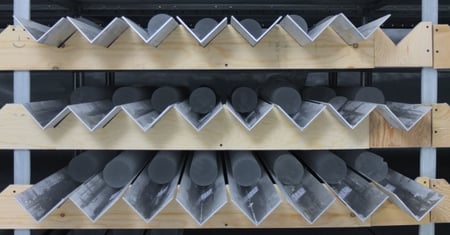All field activities in 2017 under the EGRIP finished on 24th August (previous reports are available, in 2016, in 2017). The ice was drilled to about 890 m and the deeper drilling will start again in next year.
The ice was drilled to about 890 m and the deeper drilling will start again in next year. This year is especially noticeable for deep ice coring since we (1) installed casing tubes in the borehole, (2) corrected inclination of the borehole with a new method and (3) drilled to brittle zone, where ice tends to break spontaneously. I would like to write about them briefly, not to make them too technical.
(1) Ice in ice sheets forms from deposited snowflakes, sticking each other, and then compressed by weight of overburden snow. An upper part down to 100 m has intermediate structures between snow and ice, which is called “firn”, and has permeability. Meanwhile, when the ice is drilled, the borehole starts closing due to pressure of the surrounding ice. In order to prevent this closure and to continue drilling, we use drilling fluid which has a similar density to ice. Tubes are installed in the borehole and they prevent runoff of the fluid thorough whole firn layers. Installing the tubes is a hard work because size of the tube has to be very close to that of the borehole to fix them tightly to the depth where the firn changes to ice completely. Considering the transition depth from firn to ice at this site, casing tubes to 60 m were installed with careful attentions and deeper ice coring with drilling fluid has begun.
(2) One of the problems we always have along with drilling is inclination of the borehole. Even if drill inclines very slightly as it loses its balance, the inclination tends to progress. Many attempts have been made to prevent the inclination, especially here at EGRIP, we have tested a new method with using a spring attached to the drill (picture is available here: web site of EGRIP). Position of the spring is controlled and oriented to direction of the inclination. The spring then pushes a side of the borehole and corrects the inclination close to vertical. Applying this method accompanied a few failures, however, maximum inclination of ca. 6 degree decreased to ca. 3 degree, which seems to show an effectiveness of the new method.
(3) When snow changes to ice, air is caught as bubbles into the ice, therefore, we analyze the air bubbles in the ice cores to study atmosphere and climate in the past. On the other hand, pressure of the bubbles are higher at deeper part and the bubbles expand when ice cores are taken to the top of ice sheet. This causes breaking the ice and the region where ice is easily broken is called “brittle zone”. In order to prevent breaking ice, in addition to choose optimum drill and operations, another method which cools the ice cores was tested. A freezer was installed next to the drilling workshop and was kept at -30 ℃, which is colder than temperatures during this season (-20 to -10℃). Colder ambience lets the bubbles not to expand quickly, preventing breaking the ice. Ice cores were cooled in the freezer immediately after drilling and are kept in underground snow storage to relax the pressure further, until they are analyzed in next year.
I stayed at the camp for two and half months and learned how ice cores were drilled along with my main works, physical property measurements of the ice cores and snow/aerosol sampling. I felt the deep ice coring techniques have been established by condensing human wisdom, against drilling through the massive ice sheets. Since several new attempts have been made especially in this year, I expect the EGRIP ice core has much better quality than that previous ice cores have.
Wataru Shigeyama(The Graduate University for Advanced Studies, a collaborator of theme 2)
*This article was written in September 2017.

Casing tube for borehole (by Dr. Kenji Kawamura)

Ice cores being kept in the trench (by reporter)

Drillers’ conversation (Mr. Matthias Huether (Alfred Wegener Institute for Polar and Marine Research, Germany) and Dr. Fumio Nakazawa (National Institute of Polar Research, Japan)) (by reporter)

Sunset at EGRIP camp (the sun went down from the middle of August, by reporter)





